Anise Hyssop (Agastache Foeniculum): Plant Care and Growing Guide
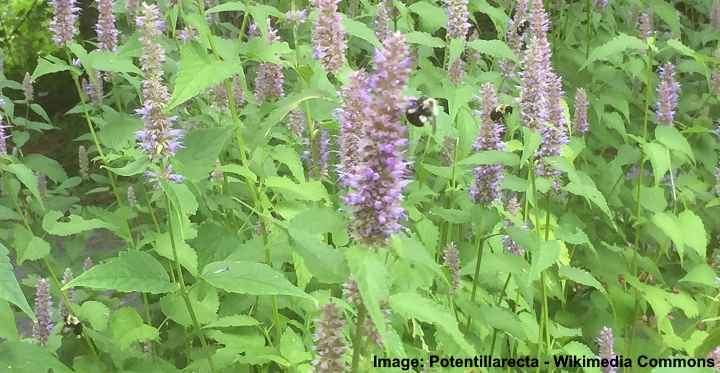
Anise hyssop (Agastache foeniculum) is a perennial herb with short purple flowering spikes and aromatic green leaves with aniseed scent. Also called the ‘blue giant hyssop,’ the anise hyssop plant is an excellent small bushy shrub to add color and aroma to garden borders, herb gardens, foundation plantings, or mixed beds. Anise hyssop purple flowers are also ideal for floral arrangements.
Anise hyssop also has many uses. Apart from being an attractive shrubby plant in most garden landscapes, anise hyssop is an edible herbaceous plant. The fragrant lanceolate leaves can add an aniseed flavor to fresh salads or herbal infusions. You can also cut the purple hyssop flowers and hang them to dry.
This article is a complete care guide to growing anise hyssop in your backyard. You will also get handy tips on how to grow anise hyssop plants in pots as an herbaceous houseplant.
How to Care for Anise Hyssop
To care for anise hyssop, grow the plant in a sunny part of your garden. Agastache foeniculum grows best in well-draining soil. Water the ‘hyssop’ plant occasionally to keep the ground moist. Trim the plant’s stems in spring and deadhead the purple flowers during summer to encourage more blooms. Anise hyssop dies back in the winter and comes back to life in spring.
What is Anise Hyssop?
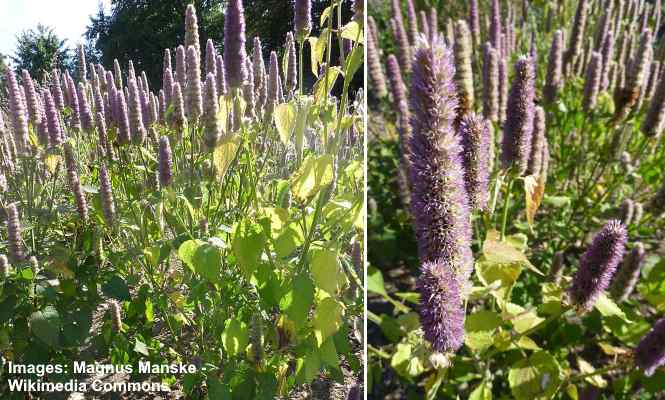
Anise hyssop (Agastache foeniculum)
Anise hyssop (Agastache foeniculum) is a perennial herbaceous plant in the mint family Lamiaceae. The woody shrub is native to North America and grows on prairies and the Great Plains. The anise hyssop plant grows in clumps and spreads through rhizome roots. Purple giant hyssop has bright lavender flower spikes and oval, pointed leaves.
Anise hyssop grows between 2 and 4 ft. (0.6 – 1.2 m) tall and is 1 ft. (0.3 m) wide. From spring until fall, the plant has a bushy appearance, dense foliage, and tall flowering spikes. The fast-growing shrub usually blooms during the first year. The Agastache plant is tolerant of drought and grows in most types of soil.
Despite its name, anise hyssop shouldn’t be confused with the aniseed plant (Pimpinella anisum), star anise (Illicium verum), or the hyssop plant (Hyssopus officinalis). The common name anise hyssop comes from the oval pointed leaves that smell like licorice and its growth habit like hyssop plants. Other common names for anise hyssop include blue giant hyssop, lavender giant hyssop, and fragrant giant hyssop.
Anise hyssop thrives in USDA zones 4 through 9 and blooms throughout the summer. In warmer regions, anise hyssop is a semi-evergreen flowering shrub. In colder climates, the perennial shrub dies back to the ground. Then in spring, the plant comes back to life and produces scented foliage and bluish-purple flowers.
Anise Hyssop Flowers
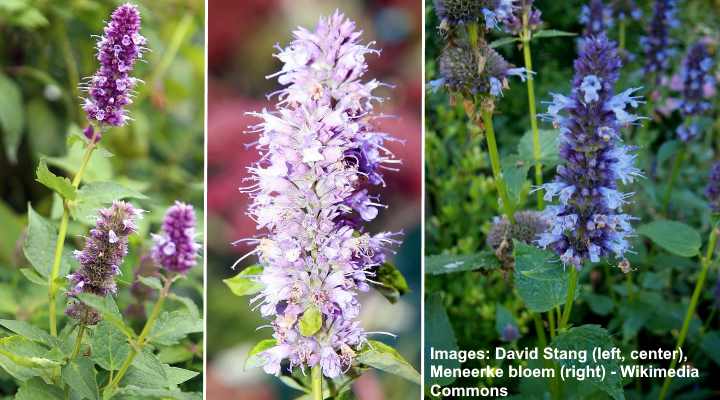
Anise hyssop Flowers
Anise hyssop flowers are showy spikes of small flower clusters, ranging in color from light blue to purple. The flowering hyssop spikes can grow around 4 ft. (1.2 m) tall and bloom during summer. The purple fuzzy spikes of blue flowers give off an anise and peppermint scent when crushed.
Anise Hyssop Seeds
The giant hyssop plant quickly grows from seeds. You can harvest anise hyssop seeds from the seed pods after flowering. To get the seeds, gather the stems into a bunch and hang them to dry. Put a paper bag around the flower heads as they are drying. The seeds will fall into the bag.
Anise Hyssop Leaves

Anise hyssop leaves
Anise hyssop leaves are light green and oval to lanceolate shaped with toothed margins. Aromatic anise leaves look like mint leaves but give off a licorice, anise, and mint scent when crushed. The licorice-scented leaves from anise hyssop shrubs are 4” (10 cm) long.
Anise Hyssop (Agastache foeniculum) Care Guide
What’s the best way to care for anise hyssop plants in your garden?
Here is a guide to growing the attractive fragrant, herbaceous anise hyssop plant in your backyard.
Where to Plant Anise Hyssop (Agastache foeniculum)
Grow anise hyssop plants in the sunniest part of your garden. Blue hyssop also withstands partial shade, where it will grow well and bloom all summer long. Anise hyssop is an excellent flowering plant for growing along borders, complementing herb gardens, or attracting pollinators such as butterflies. The bushy look of anise hyssop makes it an ideal plant for informal landscapes.
Anise hyssop is susceptible to juglone toxicity; therefore, you shouldn’t plant it near black walnut trees.
Light Requirements for Growing Anise Hyssop Outdoors
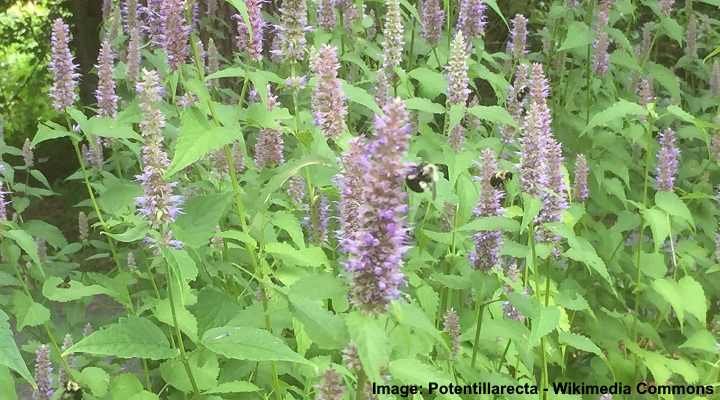
Anise hyssop grows best in full sun but can also grow in partial shade
Anise hyssop plants thrive in full sun, where they get at least six hours of sunlight daily. If you live in a warmer climate such as USDA zones 8 or 9, then it’s best to plant this hyssop plant in partial shade. Plenty of sunshine will encourage plenty of purple spikes to bloom from late spring until the end of summer.
Anise hyssop seeds require light to germinate, so don’t cover them before the seedlings appear.
If you grow anise hyssop in a container indoors, place the potted herb near a bright window. You will need to protect the plant from intense midday sunshine if it’s on a south-facing windowsill.
The Best Soil to Grow Anise Hyssop
Anise hyssop shrubs grow in most types of soil in your garden. The best kind of soil for anise hyssop is sandy or loamy soil that has excellent drainage. However, it doesn’t matter if the ground is slightly acidic or alkaline or has much clay—anise hyssop plants will thrive in most gardens.
The most crucial care factor for anise hyssop to flower and produce plenty of foliage is to grow it in well-draining soil. It’s also a good idea to work plenty of organic matter into the ground. The addition of peat moss or compost helps to retain moisture without becoming overly soggy.
If the ground has a lot of clay or doesn’t drain well, you should work in horticultural sand or perlite. Soil amendments such as perlite help water to drain freely and prevent plant roots from becoming waterlogged.
How Much Water Anise Hyssop Needs
Anise hyssop doesn’t need much watering. You only need to water the licorice-smelling plant enough to prevent the ground from completely drying out. However, anise hyssop tolerates dry soil, and established plants are relatively drought-tolerant. When watering your garden, ensure that you don’t over-saturate the ground where anise hyssop grows.
You may find that purple giant hyssop leaves start to drop, and flower stalks wilt in periods of drought. To help revive your aromatic herbaceous plant, thoroughly water the soil. Very soon, the extra moisture in the ground will bring the summer shrub back to life.
Temperature and Humidity for Anise Hyssop to Grow Outdoors
Anise hyssop is a hardy perennial that grows well in USDA zones 4 through 8. Anise hyssop shrubby herbs grow in temperatures between 55°F and 90°F (12°C – 32°C). For healthy growth, the minimum soil temperature is 60°F (15°C). When it’s hot and sunny, you will need to water the sun-loving plant more frequently.
In fall, when the temperature drops in colder climates, anise hyssop dies back to the ground. You can prune any dead stems. The anise plant tolerates hard frosts in zones 4 and 5 without any damage. However, you could put a layer of mulch over the root area for extra protection.
When temperatures start to warm in the spring, anise hyssop shrubs come back to life.
Fertilizing Anise Hyssop
Agastache foeniculum benefits from yearly fertilizing in spring to keep their purple blooms vibrant. As well as providing nutrients with organically-rich compost, you can apply a soluble balanced fertilizer. You can use an organic fertilizer with an NPK rating of 10-10-10 to encourage healthy foliage and flowering.
Anise hyssop needs little care and maintenance during spring and summer to produce its beautiful lavender flower spikes. You’ll also find that snipping off spent flowers in late spring encourages more blooming as this energizes the easy-care garden plant.
Pruning Anise Hyssop
Like many herbaceous shrubs, regular pruning encourages bushy growth on anise hyssop plants. The best time to prune anise hyssop is in early spring. You can cut the stems on the bushy shrub back by one-third. To prune this “hyssop” plant, snip the woody stems at an angle just above a leaf node.
You could also prune anise hyssop after the first set of blooms have appeared. Removing the spent flowers encourages more bluish-purple flowers to bloom. After trimming stems in spring, it’s crucial to hold off any more pruning. New growth develops on pruned branches, and you risk damaging it when the cold weather appears if you prune in summer.
You can also trim back anise hyssop when the plant dies back in winter. However, you can leave the bare stems as they are or cut the plant back to the ground.
Propagating Anise Hyssop (Agastache foeniculum)
The anise hyssop plant is an herb that is easy to propagate. You can grow anise hyssop from seed, by plant division, or by rooting stem cuttings. The fast growth of this hyssop-type plant means that it quickly establishes itself in your garden. Anise hyssop also readily self-sows.
Let’s look in more detail at the three ways of propagating anise hyssop plants.
How to propagate anise hyssop from seed
To propagate Agastache foeniculum from seed, you can collect them from dried anise flowers or buy them from a garden store. Anise hyssop seeds germinate by cold stratification. This process involves exposing them to the cold and then providing moisture.
The best way to propagate anise hyssop is to sow the seeds in the ground in your garden. In early fall, sprinkle the anise seeds about 3” (7.5 cm) apart and gently press them down. Anise hyssop seeds need light to germinate, so don’t bury them too deeply.
During winter, water the ground just enough to keep the soil from drying out. Then in spring, when days get longer and warmer, the anise hyssop seedlings will sprout. When there are at least two leaves, thin the seedlings by planting them about 2 ft. (60 cm) apart.
Alternatively, you can propagate anise hyssop from seeds indoors. About eight weeks before the last frost date, sow anise hyssop seeds 1” (2.5 cm) apart in a tray with moist potting mix. Lightly cover with soil, but don’t put a lid on the germination tray. Place the tray in a sunny location and keep the temperature between 65°F and 70°F (18°C – 21°C).
Mist the soil occasionally to keep it slightly moist. Seeds will germinate in about 10 to 15 days. When there is a set of leaves and no chance of frost, transplant the anise hyssop seedlings to the garden.
Propagating anise hyssop by root division
Dividing existing anise hyssop plants in early spring is an easy way to propagate new shrubs. Anise hyssop grows from tuberous roots that you can easily separate.
To divide an existing plant, dig around the drip line of the shrub. Then use your shovel to loosen the plant from the ground. Gently lift the shrub from the ground and remove any excess dirt. Using your shovel, cut the shrub into two or three sections, ensuring plenty of stems on each root section. Replant the root sections in your garden.
Propagate anise hyssop by using stem cuttings
Propagate Agastache foeniculum plants by taking stem cuttings in early summer. Cut new-growth stem cuttings about 6” (15 cm) in length. Then remove the ‘hyssop’ leaves from the bottom section of the stems. After that, dip the cut ends in rooting hormone and place in a moist potting medium about 2” (5 cm) deep.
Keep the anise hyssop stem cuttings in a sunny location but protected from direct sunlight. Ensure that the potting mix never dries out completely. Once the cuttings have taken root, you can transplant the cuttings to your garden.
Top care tip for propagating anise hyssop: Remember that anise hyssop plants tend to wilt after transplanting. However, this is just temporary, and the plant should start thriving after it has adapted to its new surroundings.
Pests Affecting Anise Hyssop Growth
Anise hyssop is a hardy perennial that is resistant to most pests.
Diseases Affecting Anise Hyssop Growth
Anise hyssop is susceptible to fungal diseases caused by excessive moisture in the ground or air. Hyssop plant diseases typically occur when the rhizome roots rot due to overwatering or poor soil drainage. This results in stems becoming diseased near the base or leaf spot.
Planting anise hyssop shrubs too close together can cause powdery mildew. This white powder-like mold makes leaves look unsightly. However, the good news is that it doesn’t damage the plant.
The best way to avoid diseases affecting anise hyssop growth is to water them properly. Anise hyssop tolerates drought and dry conditions. So, you only have to water the ground just enough to keep the roots moist. If water pools around the stems, you should amend the soil to increase drainage.
To prevent powdery mildew, ensure there is enough room between plants for air to circulate. If necessary, you could divide anise hyssop shrubs to make them smaller and plant them further apart. This way, you can avoid fungal leaf issues.
Growing Anise Hyssop in Pots
Anise hyssop is a great perennial herb to grow in containers. Like other indoor potted herbs, anise hyssop thrives in a bright, warm location. The licorice-scented plant flowers continuously during spring and summer with its aromatic purple flowers that smell like aniseed and mint.
To grow anise hyssop indoors, plant in a porous potting mix with excellent drainage. The best potting mix should be a combination of houseplant soil, peat moss, and perlite. Water anise hyssop only when the top layer of soil dries and place in a sunny location but protected from direct sunlight.
Types of Anise Hyssop (Agastache foeniculum) for Your Garden
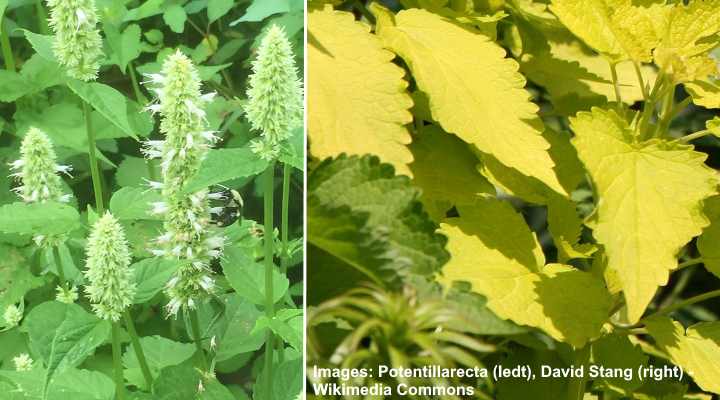
Anise hyssop has several cultivars. Left: Agastache foeniculum ‘Alabaster’ with creamy white flowers. Right: Agastache foeniculum ‘Golden Jubilee’ with golden yellow foliage
There are several Agastache foeniculum cultivars and hybrids that grow well in gardens. These anise hyssop varieties have stunning flower spikes in deep purple, bluish-violet, and creamy white. All the anise hyssop cultivars have leaves with licorice aromas and aniseed-scented flowers.
Here are some interesting types of anise hyssop to plant in your sunny garden:
- Agastache foeniculum ‘Alabaster’—The anise hyssop ‘Alabaster’ cultivar has creamy-white flowering spikes that grow up to 3 ft. (1 m) tall. The aniseed-scented leaves create a bushy herbaceous shrub. The white anise hyssop flowers attract pollinators.
- Agastache foeniculum ‘Blue Boa’—The anise hyssop ‘Blue Boa’ variety has stunning flower spikes covered in clusters of blue-violet flowers.
- Agastache foeniculum ‘Blue Fortune’ – Compared to ‘Blue Boa’, ‘Blue Fortune’ has lighter colored violet blue flowers and narrower flower spikes.
- Agastache foeniculum ‘Golden Jubilee’—The anise hyssop ‘Golden Jubilee’ has bright golden-yellow leaves that smell of licorice. The anise hyssop purple flowers contrast nicely with the yellow foliage.
Related articles:
